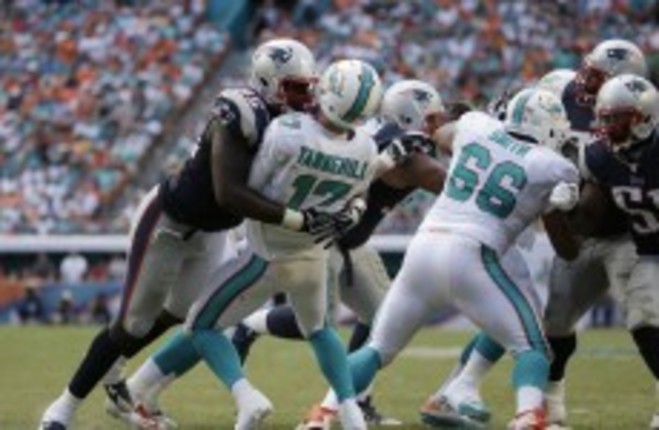THE NEW NFL season is nearly upon us and, once more, the American football audience is set to grow on this side of the Atlantic.
With that in mind, we’re putting together a number of guides designed to improve the viewing experience of rookies and casual fans alike.
If you know the difference between a Jet Sweep and an End Around, then this may not be the guide for you but, fear not, we’ll have more in-depth coverage for long-time NFL fans as the season nears.
You can also check out our Coaches Film series – which explores the sport in greater detail – here.
In this edition, we’ll focus on 10 terms you’re likely to hear in nearly every game this season.
General
Line of Scrimmage
The invisible line that no player from either team is allowed to cross until the ball is snapped.
It’s worth noting that if it is a defensive player who is offside, the play is not stopped as the offensive team may decide to take any yardage gained rather than the automatic first down.
Forward Progress
You’ll sometimes notice in the NFL that the play can restart from a position well in front of where a player is actually tackled.
This is because the forward progress rule states that the football should be located (spotted) where the ball carrier’s momentum takes him to, even if he is subsequently pushed backwards by the opposing team.
Football move
The good news is that the NFL has actually decided to change the wording of the rule that meant the above was ruled not to be a catch because he didn’t have the ball long enough to ‘perform any act common to the game’ otherwise known as a football move.
The bad news is they’ve made it much, much worse. Now the player catching the ball has to remain upright for long enough to “demonstrate he is clearly a runner.” Bring back the football move we say.
Penalties
Pass interference
Pass Interference — also commonly referred to as PI — is a foul that occurs when one player interferes another’s ability to make a fair attempt to catch a forward pass. It can be called on defensive and offensive players.
Offensive pass interference usually results in a 10-yard penalty while defensive pass interference sees the ball moved to where the foul occurred.
Holding
Holding is something that happens on every single play in the NFL and is called on less than 10%. It is officially referred to as the illegal restraining of another player who is not in possession of the football.
The most common type of holding penalty sees offensive linemen punished as they attempt to stop a defensive player getting to their quarterback or running back. This is a 10-yard penalty.
Defensive holding, which is rarely called, is a 5-yard penalty and automatic first down.
Roughing the Passer
If holding is not called often enough, roughing the passer has the exact opposite problem in that it is called far too often in a league that values quarterbacks above every other player on the field.
Under the rule, quarterbacks cannot be hit once they have released the ball on a passing play.
However, it is controversial because it can sometimes be called when the contact is made less than a second after the ball is released, when the tackler is already mid-tackle, or when, like above, the contact is minimal.
Plays
Onside kick
On a regular kick-off, the kicking team tries to pin the receiving team as far down field and away from their own endzone as they can.
On an onside kick, the defence will kick the ball in such a way that it only travels the minimum 10 yards required and try to regain possession.
Once the ball goes 10 yards or the receiving team touches it, the kicking team can attempt to reclaim possession and it is usually attempted because they are one score down late in the game.
Safety
As was the case on the very first play of Super Bowl XLVIII, if a defence tackles an offensive player inside his own endzone, a quarterback runs out of bounds in his own endzone or offensive holding is called on the attacking team in their own endzone, then a safety is awarded.
This results in two points for the defensive team as well as possession of the football after a free kick.
Two-point conversion
Instead of kicking the extra point a team can ‘go for two.’
After a touchdown, they have one play to again get the ball inside the endzone for two points.
More often than not a team will kick the extra point, but rule changes brought in this year — which sees the typical kick moved back 13 or so yards — may encourage teams to attempt a two-point conversion more often.
Play-action
A play-action pass is one where the attacking team pretend to run the football when, actually, they have a passing play in mind.
The idea is to punish overly aggressive defences who ‘bite’ on the run which leaves receivers free down field.
A draw play is when a team ‘fakes’ that it is about to throw the ball when actually the intention is to run it.
Read more of our introduction to the NFL here.

